In autumn, flower beds in many gardens take on a dull appearance: the last asters, chrysanthemums, marigolds, and other hardy plants fade away. Adding vibrant and rich tones to your flowerbed until the first frosts is possible with the help of an unusual plant – ornamental cabbage. Below, you’ll find a list of ornamental cabbage varieties with photos and descriptions of their key characteristics.
Table of contents
Description of Ornamental Cabbage
Ornamental cabbage, also known as Brassica oleracea, originated in Japan. It was there that people not only appreciated the vegetable’s taste but also recognized its beauty. By working on the shape and colour of the leaves, breeders developed numerous varieties that rival the beauty of roses.
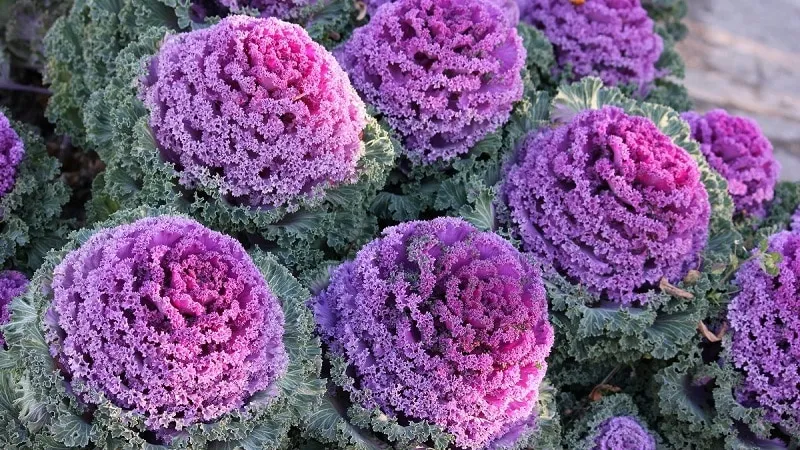
The wild form of this plant can be found in Greece, Italy, and along the Mediterranean coast. This lacy beauty is divided into two structural types:
- Head-forming – produces a loose head with slightly overlapping leaves, resembling a peony or rose.
- Leafy (palm-type) – does not form a head; the rosette features deeply serrated, lacy, or frilly leaves.
Depending on the variety or hybrid, ornamental cabbage varies in leaf shape and colour.
Is It a Perennial or Annual Plant?
Ornamental cabbage is a biennial plant: in the first year, it forms a leaf rosette, and in the second year, it produces a flower stalk and sets seeds. If you don’t need to harvest seeds, it can be grown as an annual.
Where to Grow: Flower Beds or Pots
Ornamental cabbage is perfect for mixed flower beds (mixed borders). By autumn, many plants in such flower beds have already finished blooming. What remains decorative are perennial grasses (barley, miscanthus, blue fescue), asters, chrysanthemums, and cold-resistant annuals (dusty miller, ageratum, marigolds, amaranth, celosia). At this time, ornamental cabbage fully reveals its vibrant colours and lush foliage.

Where and with which plants does this "vegetable rose" look best?:
- As a replacement for bulbous plants. After early spring flowers fade, gaps appear in flower beds. Ornamental cabbage fills these spaces more economically than other flowers (requiring half as many seedlings).
- Single planting on a lawn. Round flower beds with different complementary varieties look stunning.
- Brassica borders along garden paths made of wood, stone, gravel, pine slices, or terracotta tiles.
- As an edging for complex perennial flower beds.
- In intricate arabesque flower beds. These are carpet-style flower beds featuring low-growing annuals, ground covers, and perennials that tolerate frequent trimming.
- As decorative tree surrounds. The dense foliage blocks sunlight from weeds, keeping the soil moist for longer.
The texture of ornamental cabbage leaves pairs well with ceramics and wood. Flower beds framed with treated timber or small-diameter logs look particularly attractive.
Note: Cabbage tolerates multiple transplants if the root ball remains intact.
Varieties with exceptional beauty, unusual shapes, or unique head sizes are best planted in containers – pots, planters, or baskets. You can also combine them with flowering annuals, ground covers, or trailing perennials like sedums, ivy, or euonymus. When creating complex arrangements, ensure the plants complement each other.
The optimal container size is 5–10 litres. Potted brassicas can be easily moved to different locations.
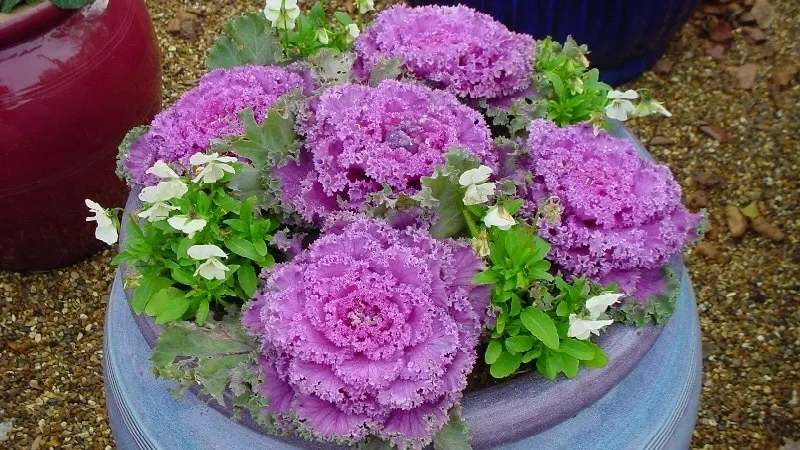
Ornamental Cabbage Varieties That Resemble Flowers
The range of ornamental cabbage varieties and hybrids is astonishing. Japanese breeders, followed by scientists worldwide, have developed diverse colours, leaf shapes, and head structures.
Emma and Liam F1
A hybrid featuring a mix of two colours: emerald green and deep purple leaves. These tall plants reach 50–70 cm, with heavily ruffled and lacy leaves, resembling miniature palm trees.
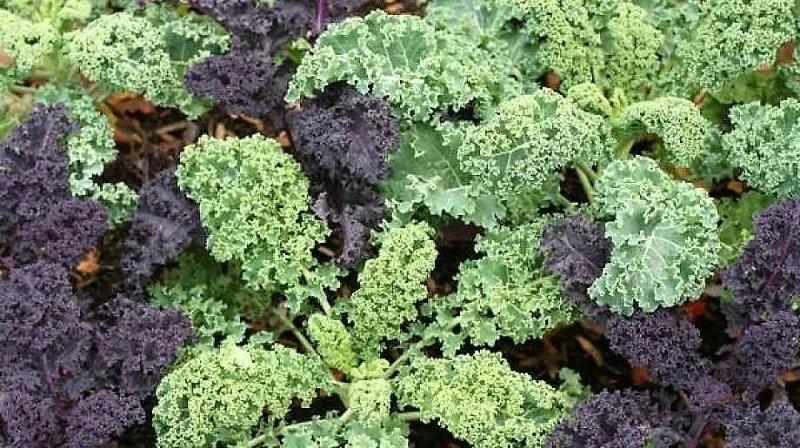
Key features include frost resistance (tolerates temperatures down to -15°C) and low maintenance. This "vegetable beauty" is not only great for flower beds but also for culinary use – perfect for garnishing dishes, summer soups, and fresh salads.
Kyoto F1
A Japanese hybrid with compact plants (25–30 cm) and a broad, loose leaf rosette. The head sits on a short stem, and each leaf has deeply ruffled edges.
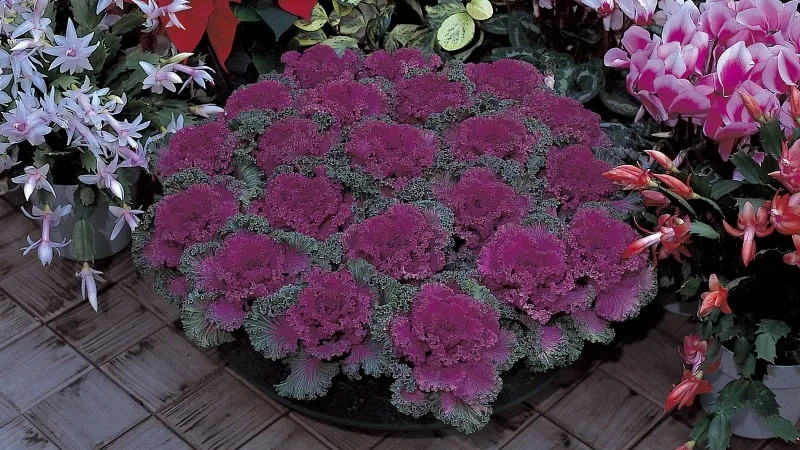
This hybrid comes in three variations:
- White – white centre with green outer leaves.
- Red – purple centre with blue-green outer leaves.
- Pink – bright pink centre with emerald-green edges.
Unlike Emma and Liam, these varieties are sold separately, not as a mix.
Tip: The centre colour intensifies as temperatures drop, eventually dominating the rosette.
Osaka
This variety comes from Japan. A compact cabbage (up to 30 cm) resembling a blooming pink peony. The bright pink centre contrasts beautifully with the emerald-green lower leaves. The head is loose, round, with slightly wavy, bubble-like leaves curling toward the centre.
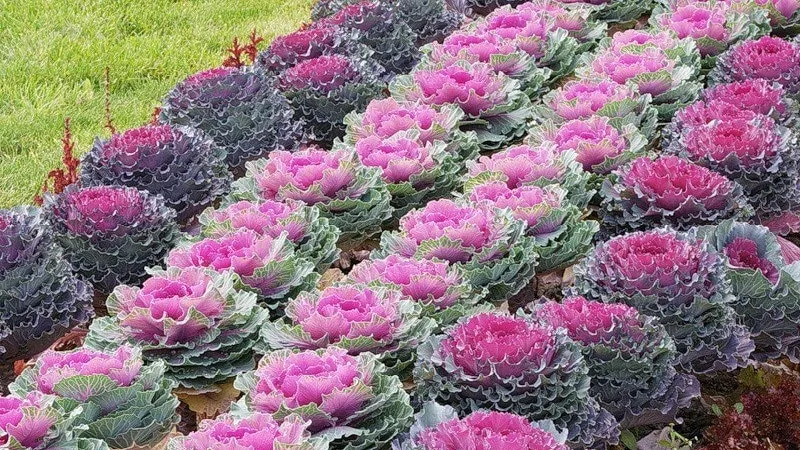
Like Kyoto, Osaka comes in red, pink, and white-centred varieties.
Hiroshima F1
Similar to the Osaka variety but taller (55–60 cm) and more shade-tolerant. Withstands brief frosts down to -8°C.
Serenade
A miniature brassica, only 22–25 cm tall. Its round, flattened heads with heavily ruffled leaves are eye-catching. This compact variety doesn’t take up much space in flower beds.
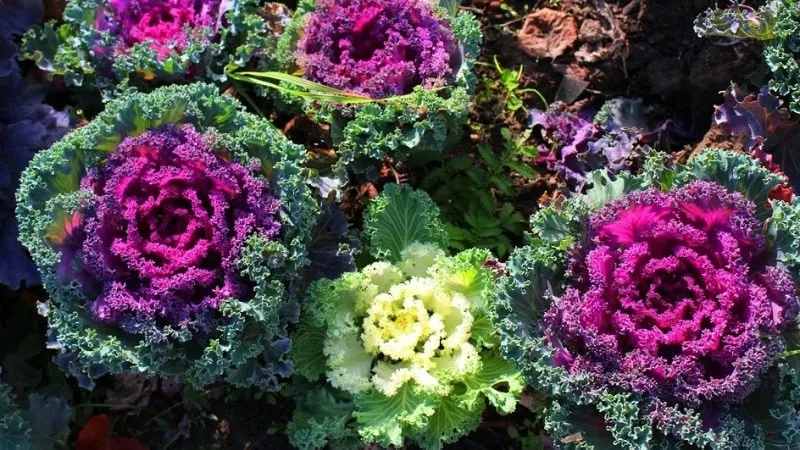
Outer leaves are dark green, while inner ones can be cream, white, raspberry, or pale pink. Sometimes sold as a colour mix. Serenade is susceptible to damping-off, so avoid overwatering seedlings.
Sunrise F1
Bouquets of this cabbage could easily be mistaken for spray roses. A long central stem (45 cm) produces multiple thin stems, each topped with a rosette resembling a rose bloom.
The inner leaves are bi- or tri-coloured: green at the edges, white in the middle, and pink at the centre. The transition between colours is smooth. Florists use Sunrise in bouquets by removing lower leaves.
Russian Circle
A mix of lacy cabbage varieties. The heads are compact (25–30 cm tall), round, and rose-like. Leaves are smooth-edged and rounded. Lower leaves are dark green, while the centre comes in shades of yellow, red (including deep crimson), cream, and green. The veins and edges may also be brightly coloured.
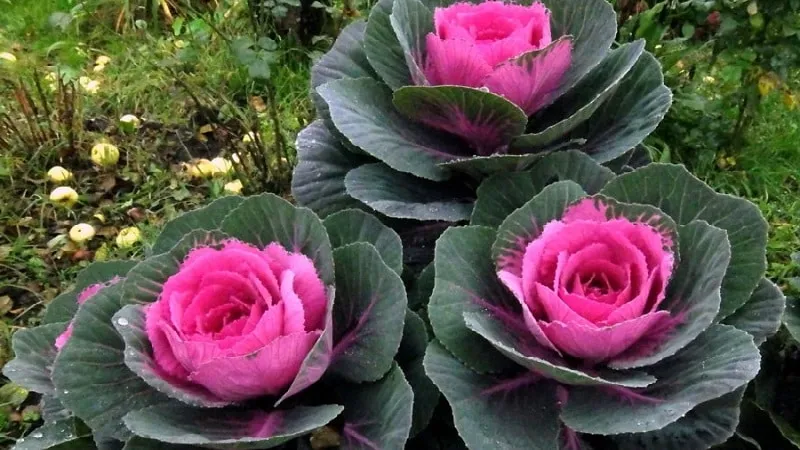
If transplanted into a pot in autumn, it will brighten windowsills until New Year’s. Works well in cut arrangements. Prefers full sun and fertile soil.
Lace Collar F1
Grows 40–50 cm tall with heavily ruffled, lace-like leaves. The rosette is round and flattened. The most striking version has a violet-blue centre, though red and white-centred varieties also exist.
Coral Queen
This hybrid creates coral-like foliage with a red centre and grey-green outer leaves. Mature plants reach 40 cm in height and 50 cm in diameter. The deeply serrated leaves resemble coral branches. Tolerates light frosts (-5°C) and remains upright even after light snowfall.
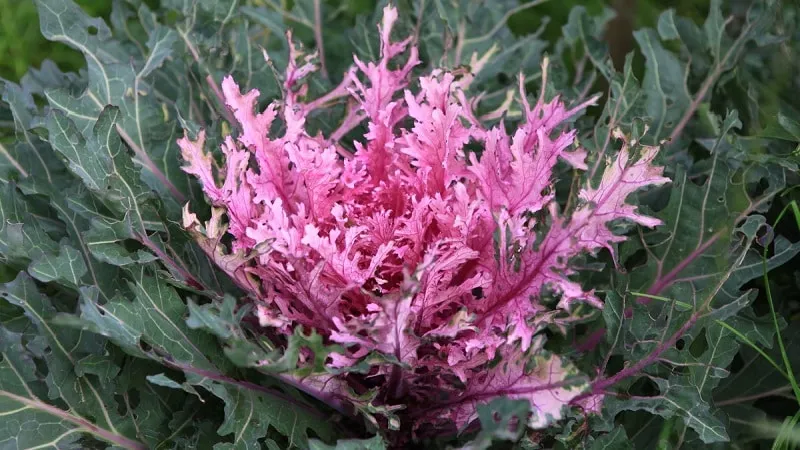
Lark’s Tongue
Notable for its pyramid shape and impressive height (up to 1.5 m). The large, flat, fringed leaves grow on long stalks (up to 70 cm). This leafy type does not form a head.
Lower green leaves gradually transition to rich pink, snow-white, or purple hues.
Conclusion
Each of these popular ornamental cabbage varieties and hybrids deserves a place in your garden – and even on your plate. Most decorative brassicas are edible, with leaves that lack bitterness, making them perfect for garnishing dishes, summer soups, and fresh salads.







